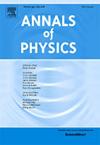大质量场论的新真空边界效应
IF 3
3区 物理与天体物理
Q2 PHYSICS, MULTIDISCIPLINARY
引用次数: 0
摘要
分析论证表明,规范理论的2+1维卡西米尔能量随着边界之间的距离呈指数衰减。非微扰数值模拟也观察到这种现象。这种指数衰减对不同边界条件的依赖性可以帮助我们更好地理解这些理论的红外行为,特别是它们的质谱。类似的现象预计在3+1维度中也会出现。基于这一特征,我们分析了3+1维时空中大质量标量场不同边界条件下卡西米尔能量指数衰减的依赖关系。我们证明边界条件可以根据卡西米尔能量的指数衰减速率分为两类。如果每个边界上的边界条件是独立的(例如,两个边界都满足狄利克雷边界条件),卡西米尔能量的指数衰减速度是边界条件连接两个边界板时的两倍(例如,对于周期或反周期边界条件)。这些结果将有助于与非阿贝尔规范理论的非摄动状态下的卡西米尔能量进行比较。本文章由计算机程序翻译,如有差异,请以英文原文为准。
New vacuum boundary effects of massive field theories
Analytical arguments suggest that the Casimir energy in 2+1 dimensions for gauge theories decays exponentially with the distance between the boundaries. The phenomenon has also been observed by non-perturbative numerical simulations. The dependence of this exponential decay on the different boundary conditions could help into a better understanding of the infrared behavior of these theories and in particular their mass spectrum. A similar phenomenon is expected to hold in 3+1 dimensions. Motivated by this feature we analyze the dependence of the exponential decay of Casimir energy for different boundary conditions of massive scalar fields in 3+1 dimensional spacetimes. We show that boundary conditions can be classified in two different families according to the rate of exponential decay of the Casimir energy. If the boundary conditions on each boundary are independent (e.g. both boundaries satisfy Dirichlet boundary conditions), the Casimir energy is exponentially decaying two times faster than when the boundary conditions interconnect the two boundary plates (e.g. for periodic or antiperiodic boundary conditions). These results will be useful for a comparison with the Casimir energy in the non-perturbative regime of non-Abelian gauge theories.
求助全文
通过发布文献求助,成功后即可免费获取论文全文。
去求助
来源期刊

Annals of Physics
物理-物理:综合
CiteScore
5.30
自引率
3.30%
发文量
211
审稿时长
47 days
期刊介绍:
Annals of Physics presents original work in all areas of basic theoretic physics research. Ideas are developed and fully explored, and thorough treatment is given to first principles and ultimate applications. Annals of Physics emphasizes clarity and intelligibility in the articles it publishes, thus making them as accessible as possible. Readers familiar with recent developments in the field are provided with sufficient detail and background to follow the arguments and understand their significance.
The Editors of the journal cover all fields of theoretical physics. Articles published in the journal are typically longer than 20 pages.
 求助内容:
求助内容: 应助结果提醒方式:
应助结果提醒方式:


